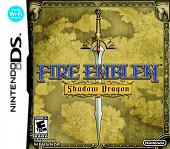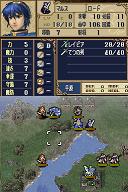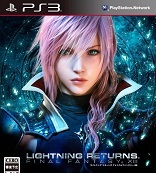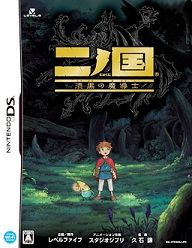Fire Emblem: Shadow Dragon
Nintendo DS
Reviewed: 4/12/2010

Fire Emblem: Shadow Dragon reverses that silly trend of naming things “DS.” Like, Resident Evil: Deadly Silence and all that. Instead it opts for brilliant “SD.” They could have gotten away with “Dragon of Shadow” or “Dragon’s Shadow,” but they decided “Shadow Dragon,” because, man, screw all those conformists. We doing it old school! And then, even though the title is composed of the letters that make DS, because we put them in a different order, we have plausible deniability! Also because “Shadow Dragon,” might actually be a pretty informative title, even though what it really needs to be called is Fire Emblem: The One with Marth. Maybe in a few years they’ll remake Fire Emblem: The Sword of Seals and they will correct the titling mistake of Shadow Dragon, and call Sword of Seals “The One with Roy.” Except the people who would have cared about Roy would all be in their mid to late twenties and too busy with their office jobs and cocaine addictions to give a toot about Fire Emblems.
That said, Fire Emblem: Shadow Dragon is The One With Marth, coming to the states about 8 years too late to sate anyone’s curiosity, it is the second remake of the first Fire Emblem game, called “Dark Dragon and the Sword of Light.” The first remake was for the Super Famicom, and unlike most remakes that would put in some extra material, it omitted characters and chapters, although it provided a sequel. Shadow Dragon is a much more faithful remake in that it does not omit anything from the original game unless the omission was getting in the way of modernizing the play of the game – it is not the same game, but a faithful recreation. No chapters are missing, and new ones are inserted if one bothers trying to unlock them.
But, for those not familiar with Fire Emblem, this is a Tactical RPG, in line with the spirit of Shining Force and Final Fantasy Tactics, although those games came along as imitators of Fire Emblem, as the original NES game was quite original. The game is broken up into several chapters, the bulk of which is made up by tactical battles. You start out with a handful of unique units (as in, there are no generics as in FFT, or Disgaea) and have numerous opportunities to recruit more. Every character belongs to a class which imbues that character with certain weapon proficiencies and stats. Cavaliers sacrifice some speed for overall balance and the ability to move far, Pegasus knights are much faster and maneuverable, but susceptible to arrows. Mages cast spells, and since enemies rarely have resistance to magic, generally end up doing heavy damage. Knights move slowly, but are tanks. Thieves can open chests and doors, clerics can use staves to heal, etc. There are terrain restrictions and bonuses, and the sort of thing that has become standard fare in the minds of TRPG players.
What is different here from the original Fire Emblem, and indeed other Fire Emblems, is the class changing mechanic. Now, characters are not trapped in their starting class – Gordin does not have to remain an archer, and Cain and Abel must not be cavaliers. This mechanic imbues the game with a large sort of variability in the main campaign, and is perhaps quite necessary for the Online component of the game. Although the game sets limits on the number of classes one can have in the army of 1 + the largest possible number of potential characters with that class as their default. Another small addition to the basic formula comes from Fire Emblem: Radiant Dawn, where the player can keep track of an enemy by selecting them, which marks their range in red. This is a handy addition that relieves the tediousness of having to manually count out the enemy’s range. Overall, however, the gameplay remains unchanged from the above formula. You have the option of making all your choices via stylus, or just using buttons as it nothing changed. The top screen is used to show the map of the entire chapter, or it shows the stats and equipment of the targeted character.
 |
Although the game’s Normal difficulty is pitifully easy, when one chooses to select the Hard difficulty, the game happens to provide a high degree of difficulty variability. The game’s most difficult setting is a monstrosity, with the first chapter’s closest enemy being able to eviscerate the Pegasus Knight you are likely to throw at him. Because of the six difficulty modes, none can truly complain about the game’s lack of challenge. Anyone who can beat the game’s Five Star Hard Mode deserves a serious high five. Feel free to facepalm.
The story remains unchanged. The Normal Mode adds a prologue to the story not present in the original game which covers Marth’s recruitment of his Chapter 1 company and his escape from Altea as the Gra army overtakes his castle. It turns out, Altea’s closest ally, the country of Gra has teamed up with the Dragon Kingdom of Doluna, who is now ruled by the once Sealed Evil in a Can, the Earth Dragon Medeus. Marth’s ancestor Anri once defeated Medeus using the Falchion, but a wizard named Gharnef ended up resurrecting him. And now, Medeus and Gharnef convinced several countries to betray their allies and start a continent wide war. Now Marth, as Anri’s descendant, must defeat Medeus and give the continent back to those from whom it was taken.
No one is going to pretend that this is a deep story. It is a very simple story, told in a very simple way. It hints at some small politics of the kingdoms Marth comes through, but he never stays long, and the characters with speaking lines are recruited quickly and fall into the Silent PC Syndrome that plagues all Tactical RPGs which employ permanent character death. Many of the characters Marth recruits have no speaking lines at all, as in the example of all of Sirius’s and Ogma’s men. Unlike the original version of the game, they are blessed with death quotes. But who cares?
The graphics were reworked from scratch, as would be expected for a remake of an NES game. The character portraits tend to be well drawn, although some look strange, and awkward, specifically Marth post Prologue, where he seems to be missing a neck. The sprites do their job well enough. The battle screen however is not done well. The 3D character models stand on a pre rendered 2 dimensional battleground, and this ends up looking sloppy, if not outright ugly. This is a negative change from the way the Gameboy Fire Emblems handled battle terrain, represented by hand drawn sprites on tiles representing the terrain they stood on, which looked quite well done.
Fire Emblem: SD comes with an online component. The wifi shop sells rare items to be used for the multiplayer or for the campaign, different items on different days. It also has a multiplayer bit, where people can use their different teams to duel each other. This is much better implemented than the Gameboy game’s Battle Arena, which had no use of tactics, as it were simply characters dueling, being largely luck based. However, I cannot go into significant details here, as I actually never encountered anyone else who had this game, so I never got to play the multiplayer mode and cannot review it.
Many of the game’s additions provide for a boost in replayability. The difficulty modes provide additional challenges each time, and the ability to recruit different characters is always there. With a cast of roughly 50, and the standard maximum per chapter around 14 one could not possibly have used all the characters in one play. The bonus chapters are unlocked by keeping very few units on the team, either by killing off extraneous characters or by not recruiting them. The class changing mechanic keeps everything mixed up as well. Every chapter provides for a variety of strategies, depending on which classes and characters are being used.
Overall, Fire Emblem: Shadow Dragon is a good game. The awkward graphics and simplistic story do not greatly detract from the highly variable and long-lasting gameplay, which is fun above all else. Shadow Dragon is a remake that reminds us why the Fire Emblem series became such a success.
-Ivan Taran
| Score Breakdown | ||
| Overall Good Out of 10 See our Review Criteria |
Gameplay | Great |
| Story | Average | |
| Graphics | Good | |
| Sound/Music | Average | |
| Replay Value | Great | |
| The Verdict: Good | ||








